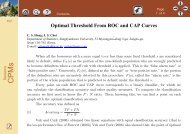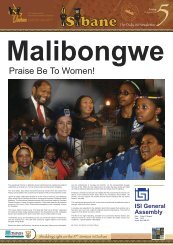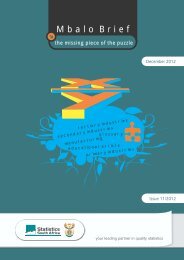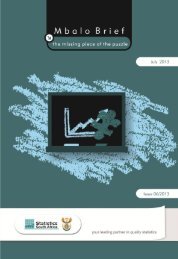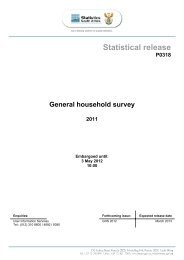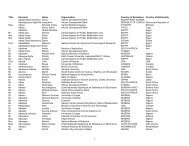Post-enumeration Survey (PES) - Statistics South Africa
Post-enumeration Survey (PES) - Statistics South Africa
Post-enumeration Survey (PES) - Statistics South Africa
You also want an ePaper? Increase the reach of your titles
YUMPU automatically turns print PDFs into web optimized ePapers that Google loves.
<strong>Statistics</strong> <strong>South</strong> <strong>Africa</strong><br />
72<br />
ANNEXURE A: CONCEPTS AND DEFINITIONS<br />
CONCEPT<br />
Born after the<br />
Census<br />
Census reference<br />
night<br />
Dwelling<br />
Dwelling unit<br />
Enumeration<br />
Enumeration area<br />
EA number<br />
EA Summary<br />
Book<br />
Final matching<br />
Final matching<br />
for estimation<br />
Household<br />
Head/Acting head<br />
of the household<br />
DEFINITION<br />
Babies who were present in the household on the <strong>PES</strong> reference night (6–7<br />
November), but who were not yet born as of midnight between 9 and 10 October<br />
(census reference night).<br />
Census reference night is the midnight between 09 and 10 October. It is in the<br />
<strong>PES</strong> questionnaire.<br />
Any structure intended or used for human habitation.<br />
Structure or part of a structure or group of structures occupied or meant to be<br />
occupied by one or more than one household.<br />
Enumeration is the process of counting all the members of a defined population<br />
and collecting demographic and other information about each person. This<br />
counting takes place by means of administering a <strong>PES</strong> questionnaire to all<br />
households in the sampled EA.<br />
An <strong>enumeration</strong> area (EA) is the smallest geographical unit (piece of land) into<br />
which the country is divided for census 2011 <strong>enumeration</strong> purposes. Each EA is<br />
expected to have clearly defined boundaries.<br />
The EA number is a unique ID number given to an EA for record-keeping and<br />
coding purposes. The first digit indicates the province. The next two digits<br />
indicate the municipality and the last five distinguish among the different EAs<br />
within the municipality.<br />
The EA Summary Book is a register of mapping and listing information pertaining<br />
to a particular EA. The summary book identifies an EA by province, local<br />
municipality, main place name and sub-place name. Maps and/or aerial<br />
photographs of the EA and adjoining areas are provided.<br />
Assigning the final match status based on reconciliation visits outcomes.<br />
Assigning the final match status for estimation for all RV and non-RV cases for<br />
persons.<br />
A household is a group of people who live together and provide themselves<br />
jointly with food or other essentials for living, or a single person who lives alone.<br />
For <strong>PES</strong> and census purposes, only people present in the household on the<br />
reference nights (census and <strong>PES</strong>) are included as part of the household.<br />
In the first instance, the head/acting head of household is the person that the<br />
household regards as such. If necessary, the head can be defined as the main<br />
decision-maker, or alternatively, the person who owns or rents the dwelling, or<br />
the person who is the main breadwinner. The head can be either male or female.<br />
If two people are equal decision-makers, the older of the two should be named<br />
as head of the household. In a household of totally unrelated persons, the oldest<br />
should be named as the household head.<br />
Initial matching<br />
Use information from the <strong>PES</strong> and census questionnaires to assign the initial<br />
match status.<br />
<strong>Post</strong> Enumeration <strong>Survey</strong> (<strong>PES</strong>)



